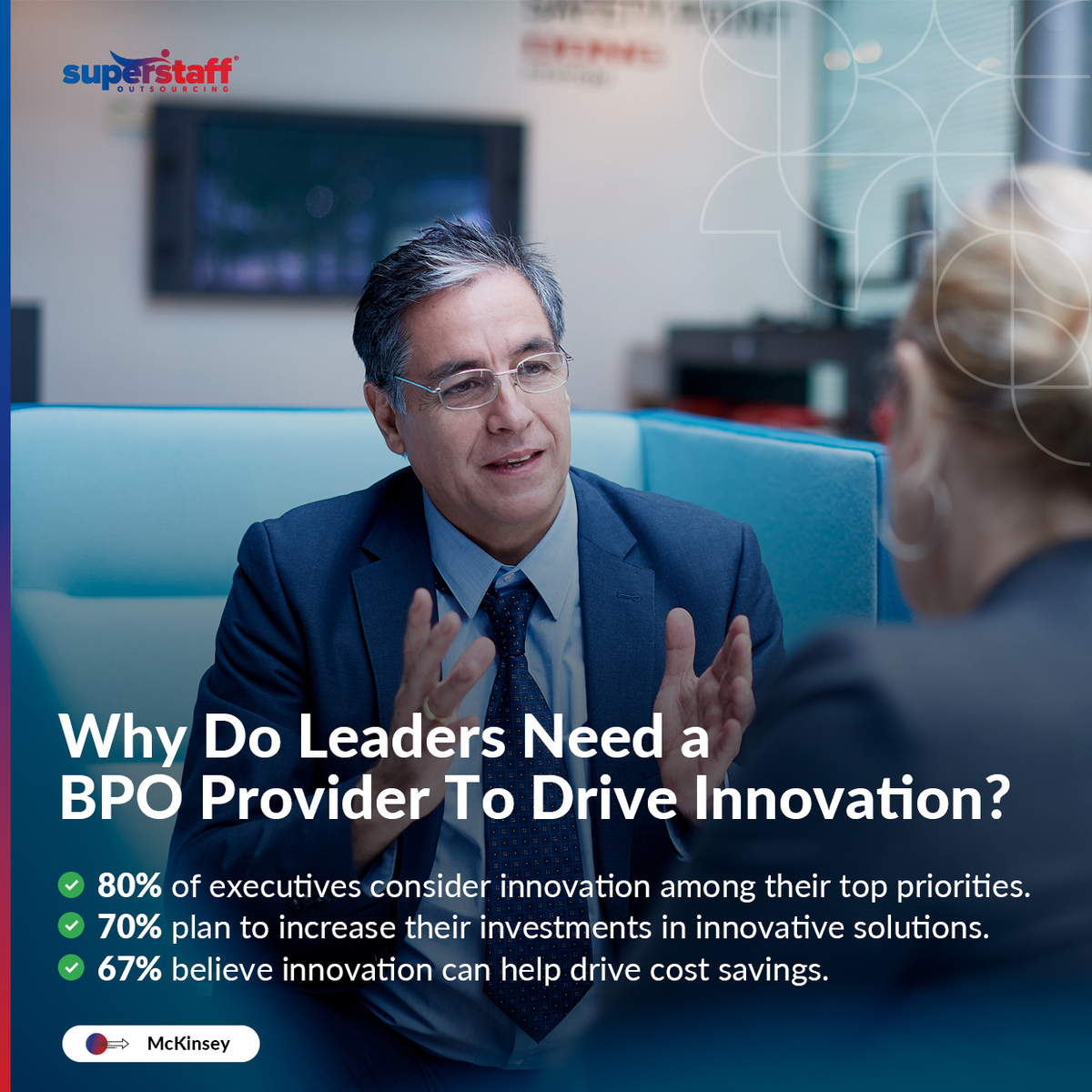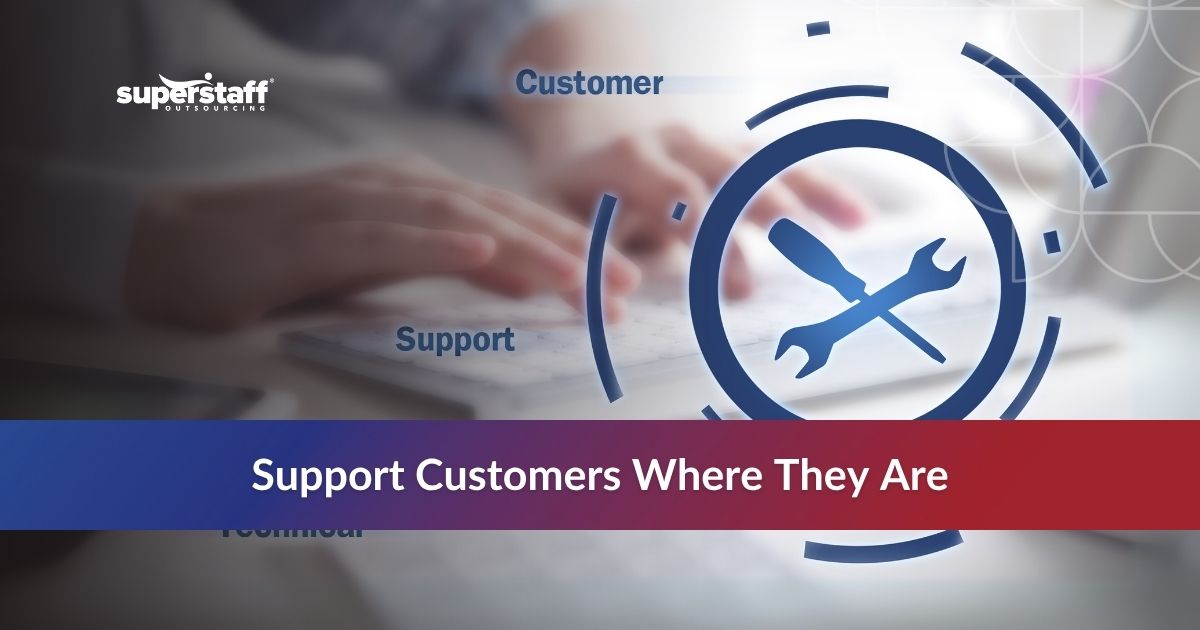
Innovation is more than just a corporate buzzword; It should be an essential part of your overall business strategy, helping you improve market growth, stay ahead of the competition, and boost customer satisfaction.
Here’s the problem: Accelerating innovation is no easy task. To fully transform your operations, you’ll need to be open to new perspectives, possibilities, and strategies.
One way to foster breakthrough ideas and spark positive change is by partnering with an innovative BPO provider.
Today, business process outsourcing partnerships have evolved from cost-saving measures to strategic alliances driving innovation. As a Chief Information Officer, you hold the key to leveraging these partnerships for groundbreaking ideas.
With the right partner by your side, you can unlock innovative solutions that propel your business forward. This article will provide you with practical advice on maximizing your outsourcing arrangements and driving innovation and transformation.
Understanding the Evolution of BPO Partnerships
When many think of outsourcing, the first images that come to mind are call center work, factory jobs, or back office tasks. Truthfully, the definition of outsourcing has changed so much over the years, now expanding to include a wide range of specialized services.
To better understand how working with a BPO solutions provider can help your business boost innovation, let’s first dive into the history and evolution of outsourcing partnerships.
Historical Perspective on BPO Partnerships
Western companies first realized the potential of outsourcing for driving business growth during the 18th-century Industrial Revolution. The new age created opportunities for U.S. manufacturers to partner with offshore companies, forever changing how many businesses sourced labor and raw materials.
Previously, Western manufacturers were limited by geography and could only establish factories within their home countries. However, they soon realized the advantages of outsourcing and importing labor and raw materials to faraway nations like India and China. Doing so allowed them to significantly reduce costs and tap into a larger talent pool of blue-collar workers.
From Factory Work to Contact Center Jobs
During the late 1980s to 1990s, the outsourcing sector pivoted away from factory work and manual labor, now more closely resembling the call center industry we know today.
Free-market economies boomed following the two world wars, leading to growing economic prosperity in Western markets. Because consumers now had more spending power, innovative entrepreneurs rose to the occasion, seeking ways to scale their businesses.
Many U.S. companies opted to outsource customer service to offshore BPO service providers to address the skyrocketing consumer demand. During this time, CS representatives focused on handling the large volume of customer phone calls, including both outbound and inbound services.
Transitioning to Innovation-Driven BPO Relationships
Today, business process outsourcing has evolved from simple cost-saving measures to strategic alliances focused on innovation. Although most BPOs are still closely associated with call center work, the rise of digital technologies has radically transformed the sector’s service offerings and capabilities.
For instance, contact centers no longer focus only on answering phone calls. These offshore customer service teams provide omnichannel support, working round-the-clock to answer buyer inquiries and concerns through multiple channels, including email, live chat, social media, and all other relevant platforms.
The increasingly globalized business environment also created a greater need for multilingual customer service. U.S. companies operating internationally must provide multi-language support to cater to global consumers’ diverse needs and preferences.
The Rise of Niche and Specialized Solutions
Today’s BPO solutions providers understand the need for innovation and aim to support your company’s plans to boost growth through breakthrough ideas. To meet business’s more complex needs and goals, many have begun offering specialized services, such as:
- Data Science Outsourcing: Extract patterns, trends, and insights from raw information, leveraging these when making crucial business decisions.
- Business Intelligence Outsourcing: Collaborate with BI specialists to better understand data-driven insights and elevate your financial performance and overall business strategies.
- Software Development: Create, design, and deploy software that supports your company’s daily operations and IT systems.
- Artificial Intelligence Development Support: Accelerate your AI projects without overwhelming your in-house team and overextending your budget.
- Specialty Healthcare Outsourcing: Reduce the workload of healthcare staff by offloading administrative support functions to a reliable provider.
- Legal Process Outsourcing: Help law firms scale operations to meet increasingly complex client demands.
The examples above are just a few niche solutions today’s BPO vendors can provide. The outsourcing industry has evolved to meet the changing needs of modern businesses, even providing industry-specific solutions to fill the gaps in their operations.
Key Factors Driving the Transformation of BPO Partnerships
From humble beginnings, the modern BPO industry has transformed into one of the most innovative and cutting-edge sectors across the globe. What has driven outsourcing companies to stay ahead of the curve? Here are just a few of the factors shaping this continued transformation:
Technological Advancements
Technology plays a crucial role in innovation, and BPO providers are often first in line to adopt the latest advancements. During the COVID-19 pandemic, different industries shut down or paused operations. Meanwhile, the outsourcing sector stayed afloat by leveraging remote work technologies, such as virtual conferencing software, productivity and time-keeping tools, and digital playgrounds.
Even post-pandemic, BPOs strengthened their competitive edge by continuing hybrid work arrangements and adopting tools, software, and technologies that boosted operational efficiency and productivity.
Changing Business Landscape
Beyond technological advances, the changing global business landscape has also influenced the transformation of BPO partnerships. In the past, companies turned to outsourcing for one-time transactions or seasonal spikes in demand.
Today, many businesses like yours seek comprehensive and holistic BPO solutions. Outsourcing firms succeed not just by filling temporary gaps but by continually providing strategic support that addresses your immediate needs and long-term goals.
Evolving Consumer Demands
Customer preferences and expectations are another factor driving the change in BPO relationships. During the pandemic, buyers became accustomed to personalized, convenient, on-demand services, and today, they will no longer settle for anything less than the best possible experience.
Thankfully, BPO service providers have upgraded their infrastructure, capabilities, and workforce to align with consumer demands. They keep themselves updated on emerging market trends so they can better serve your business and cater to your customers.
Choosing the Right BPO Provider for Your Company: Best Practices for CIOs

With a clear understanding of the evolution of BPO partnerships, CIOs like you can better appreciate their potential for driving innovation. Now, your next step should be to find and select an outsourcing provider that can meet your particular needs and goals.
According to a McKinsey report, 80% of executives consider innovation among their business’s top priorities. Meanwhile, 70% of companies plan to increase their investments in transformative solutions, with 67% believing innovation can help drive cost savings.
If you’re serious about investing in innovation, you should start by choosing the right BPO partner. Remember to be discerning and perform your due diligence when deciding between different vendors. Here’s your checklist for evaluating and selecting a BPO provider focused on innovation:
Expertise and Experience
When assessing your BPO partner, it is vital to evaluate their industry experience, track record, and domain knowledge. Here’s why: Before you can foster innovation through your strategic partnership, your outsourcing vendor must be intimately familiar with your industry’s challenges, requirements, and regulations. After all, how can they help you innovate if they don’t even know the basics of your business?
The most effective way to assess this is by checking their service portfolio and case studies. You can also read client testimonials and online reviews to better understand others’ experiences with your BPO provider. Ask them about their best practices, methodologies, and processes to ensure these meet your quality standards.
Innovation and Transformation Capabilities
Once you’ve established that your BPO partner has the expertise and experience you need to strengthen your operations, your next step should be to check whether they are equipped to support your innovation goals. Here are the specific factors you should consider when selecting an outsourcing vendor for innovation and transformation:
- Flexible Operational Models: Can your BPO service provider upgrade or downgrade its operations depending on your needs? Operational flexibility can allow your company to pivot and change strategies to meet your transformation initiatives.
- Technological Capabilities: Does your outsourcing team have access to cutting-edge technologies and innovations? Do they have the capability to integrate new advancements and applications into your operations when needed?
- Diverse Talent Pool: Can your BPO partner give you access to a diverse global talent pool full of professionals with specialized expertise? Working with specialists from different walks of life can help you foster innovation and growth by making room for fresh ideas and perspectives.
- Training and Upskilling: What are your BPO provider’s training and development programs? How do they ensure that your outsourced team can keep up with new technologies, processes, and innovations?
- Knowledge Transfer Policies: Will your outsourcing partner notify you about emerging trends and developments? How will they communicate new processes and policies with your in-house team?
Cultural Alignment and Shared Vision
Aligning objectives and having a shared vision is the cornerstone of a successful outsourcing partnership. As such, you must communicate your expectations and goals when negotiating with your BPO provider.
Ensuring cultural alignment is a critical part of this process. Understanding, respecting, and welcoming cultural diversity can create a working environment that fosters innovation and collaboration, even as everyone works together to achieve a common goal. Here’s how you can manage cultural differences while staying aligned on your mission and vision:
- Setting Shared Goals and Values: Ensure your global outsourcing team is involved in long-term goal-setting and strategy development. This allows everyone to stay on the same page while giving all team members a sense of unity and purpose.
- Cross-Cultural Training: Hold training sessions for in-house and outsourced workers, teaching them proper communication etiquette when collaborating with people from other cultures.
- Accommodating Time Zone Differences: Consider time zone differences when assigning tasks, scheduling meetings, and establishing regular work hours.
- Centralized Communication: Leverage digital communication channels for easier collaboration and allow everyone to share feedback and concerns.
Value Proposition and Pricing
Once you’ve narrowed down your options based on the criteria mentioned above, one final factor you should consider before making your decision is the overall value proposition. Ask yourself, “What does this BPO vendor bring to the table compared to their competitors? Which one will give my company the best value for money?”
Remember: Cost savings are essential, but choosing the cheapest option isn’t always wise. Weigh the different BPO vendors’ pricing and payment terms against their direct value to determine which provider can give you the best return on your investment.
Establishing a Collaborative Framework With Your BPO Service Provider

Once you’ve identified your ideal BPO partner, your next step is to establish a collaborative framework promoting innovation. A clear and comprehensive framework can help you maximize the potential of your outsourcing partnership, ultimately enabling you to generate breakthrough ideas together.
Studies have found that 86% of employees believe ineffective communication and collaboration are the leading cause of problems and failures in their workplace. By establishing a collaborative framework with your outsourcing provider, you can avoid misunderstandings, build trust, stay aligned in your projects and goals, and accelerate innovation. Here’s how you can get started:
Clearly define each team member’s roles and responsibilities.
For you and your outsourcing provider to collaborate effectively, you must clearly define each team member’s roles and responsibilities. When every person in your BPO team understands what is expected of them, it becomes easier to make actionable strategies, knowing how each piece of the puzzle will fit together to build a shared vision. This will make collaboration much easier and more seamless, creating fewer misunderstandings and conflicts.
Additionally, a clear understanding of roles and responsibilities helps boost employee engagement, leading to higher job satisfaction and productivity. As such, you will improve your team’s collaboration ability and help them feel more connected and engaged in your workplace.
Establish a hierarchical structure for communication and reporting.
Some people mistakenly believe that hierarchical organizational structures hinder communication and collaboration because they discourage employees from the “lower” tiers from sharing their feedback and concerns.
Here’s the truth: When done correctly, establishing a hierarchical communication structure can make sharing ideas and information easier. Why? Because they know who, where, and how to express their perspectives.
For example, if rank-and-file employees have a problem that affects their daily workload, they’ll know to contact their immediate supervisor or manager to relay their concerns. When sharing information with other departments, they’ll have a dedicated point of contact for reporting their findings.
Conversely, a disorganized structure can create communication failures. Imagine an employee not knowing who they report to, where to share their concerns, or how to give feedback to other departments. That worker may bring up an issue with the wrong contact person, who may not know what to do with the information or whether they can act on it. Vital information may fall through the cracks, hindering innovation and collaboration.
Share information and resources across departments.
Innovation happens when people with diverse backgrounds, experiences, and expertise come together and share ideas. As such, the best way to foster innovation between your in-house and outsourced teams is to pool information and resources together so you can all work on achieving a common goal.
To make this work, you must foster an environment that allows for open communication and respectful dialogue. Encourage all team members to share their perspectives, ideas, and resources to strengthen and support other areas of your operations.
Use tools and technologies that support effective collaboration.
Finally, when working with your BPO provider, use the right tools and technologies to support your collaborative efforts. For instance, you can use task management software to delegate assignments to the right team members, check everyone’s progress, keep track of due dates and deadlines, and reprioritize tasks when necessary.
Calendar-sharing tools can also be beneficial for scheduling meetings and appointments without coordinating with each person individually. Then, you can use voice and video conferencing applications to communicate with your outsourced team in real time, allowing everyone to bond and collaborate without needing to be in the same physical location.
Utilizing the proper tools and technologies can empower you to streamline your work processes, keep all communications organized, and ensure everyone will be notified of any changes to your plans. No matter where your team members reside, you can foster effective communication and collaboration, helping you generate breakthrough ideas and innovative solutions.
Leveraging BPO Partnerships for Breakthrough Ideas: A Sample Case

To further illustrate how a BPO service provider can help fuel business innovation and growth, let’s examine the case of tech giant Apple and its offshore partner, Foxconn Technology Group, a Taiwanese manufacturer.
The two companies had been working together since the 1990s, with Foxconn supplying simple components and parts for many of Apple’s products.
However, their alliance deepened during the early 2000s when Foxconn received an order to produce iMacs, the tech giant’s iconic all-in-one computer. Apple gave Foxconn strict requirements and quality standards for the iMac components, which made the manufacturer upgrade their technologies to meet their client’s demands.
Foxconn then became an integral part of the development of Apple’s iPhone. They helped the tech company achieve its aesthetic vision for the smartphone by using innovative techniques to combine aluminum parts with frictional heat to process the metal’s surfaces.
What Apple and Foxconn Are Doing Right
Outsourcing to Foxconn empowered Apple to scale production rapidly, meet worldwide demand, and save on costs while maintaining exceptional product quality standards. They also leverage Foxconn’s advanced manufacturing capabilities and automation expertise to continually stay at the forefront of innovation and deliver groundbreaking products to customers across the globe.
Throughout their partnership, Apple’s revenue has soared to $383.29 billion in 2023, with their annual revenue quadrupling in the past ten years. Industry experts have attributed their dramatic revenue growth to their constant waves of innovative products over the decades.
Here’s the moral of the story: BPO partnerships have the potential to accelerate innovation and growth. As a CIO, nurturing these relationships can be the key to unlocking sustained success for your company.
Connect With a BPO Solutions Provider To Drive Innovation and Creativity
By effectively leveraging outsourcing partnerships, you can foster breakthrough ideas and achieve your organization’s transformation goals. Following the practical tips and advice we shared in this article can help you jumpstart innovation by finding and selecting your ideal BPO provider, establishing a clear and effective collaborative framework, and creating a culture that welcomes diverse perspectives and ideas.
If you’re looking for an outsourcing partner to help you fuel business growth, turn to the professionals at SuperStaff. We work closely with you to identify your particular needs and objectives, creating a customized BPO solution that meets your requirements, goals, and quality standards.
When you partner with us, we align our services with your innovation goals, ensuring continuous business growth and strengthening your competitive edge. Get in touch with us today to learn more about what we can do for you!






